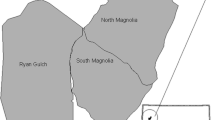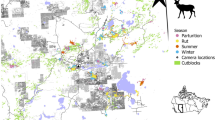Abstract
It is well established that the dynamics of mammalian populations vary in time, in relation to density and weather, and often in interaction with phenotypic differences (sex, age and social status). Habitat quality has recently been identified as another significant source of individual variability in vital rates of deer, including roe deer where spatial variations in fawn body mass were found to be only about a tenth of temporal variations. The approach used was to classify the habitat into blocks a priori, and to analyse variation in animal performance among the predefined areas. In a fine-grained approach, here we use data collected over 24 years on 1,235 roe deer fawns captured at known locations and the plant species composition sampled in 2001 at 578 sites in the Chizé forest to determine the spatial structure at a fine scale of both vegetation and winter body mass of fawns, and then to determine links between the two. Space and time played a nearly equal role in determining fawn body masses of both sexes, each accounting for about 20% of variance and without any interaction between them. The spatial distribution of fawn body mass was perennial over the 24 years considered and predicted values showed a 2 kg range according to location in the reserve, which is much greater than suggested in previous work and is enough to have strong effects on fawn survival. The spatial distribution and the range of predicted body masses were closely similar in males and females. The result of this study is therefore consistent with the view that the life history traits of roe deer are only weakly influenced by sexual selection. The occurrence of three plant species that are known to be important food items in spring/summer roe deer diets, hornbeam (Carpinus betulus), bluebell (Hyacinthoides sp.) and Star of Bethlehem (Ornithogalum sp.) was positively related to winter fawn body mass. The occurrence of species known to be avoided in spring/summer roe deer diets [e.g. butcher's broom (Ruscus aculeatus) and beech (Fagus sylvatica)], was negatively related to fawn body mass. We conclude that the spatial variation in the body mass of fawns in winter in this forest is as important as the temporal variation, and that the distribution of plant species that are actively selected during spring and summer is an important determinant of spatial variation in winter fawn body mass. The availability of these plants is therefore likely to be a key factor in the dynamics of roe deer populations.



Similar content being viewed by others
References
Aldous SE (1944) A deer browse method. J Mamm 25:130–136
Andersen R, Duncan P, Linnell JDC (eds) (1998) The European roe deer: the biology of success. Scandinavian University Press, Oslo
Andersen R, Gaillard JM, Linnell, JDC, Duncan P (2000) Factors affecting maternal care in an income breeder, the European roe deer. J Anim Ecol 69:672–682
Besag JE (1977) Comments on Ripley's paper. J R Stat Soc Ser B Methods 39:193–195
Caughley G (1977) Analysis of vertebrate populations. Wiley, New York
Charlesworth B (1980) Evolution in age-structured populations. Cambridge University Press, Cambridge
Cibien C, Sempéré A (1989) Food availability as a factor in habitat use by roe deer. Acta Theriol 34:111–123
Cliff AD, Ord JK (1981) Spatial processes. Pion, London
Clutton-Brock TH, Guinness FE, Albon SD (1982) Red deer: behaviour and ecology of two sexes. University of Chicago Press, Chicago
Conradt L, Clutton-Brock TH, Guinness FE (1999) The relationship between habitat choice and lifetime reproductive success in female red deer. Oecologia 120:218–224
Coulson T, Albon SD, Guinness FE, Pemberton J, Clutton-Brock TH (1997) Population substructure, local density, and calf winter survival in red deer. Ecology 78:852–863
Coulson T, Albon SD, Pilkington J, Clutton-Brock TH (1999) Small-scale spatial dynamics in a fluctuating ungulate population. J Anim Ecol 68:658–671
Diggle PJ (1990) Time series: a biostatistical introduction. Clarendon Press, Oxford
Donaldson DD, Nisbet RM (1999) Population dynamics and spatial scale: effects of system size on population persistence. Ecology 80:2492–2507
Dray S, Pettorelli N, Chessel D (2002) Matching data sets from two different spatial samplings. J Veg Sci 13:867–874
Duncan P, Tixier H, Hofman RR, Lechner-Doll M (1998) Feeding strategies and the physiology of digestion in roe deer. In: Andersen R, Duncan P, Linnell JDC (eds) The European roe deer: the biology of success. Scandinavian University Press, Oslo, pp91–116
Everitt B (1974) Cluster analysis. Heinemann, London
Gaillard JM (1988) Contribution à la dynamique des populations de grands mammifères: l'exemple du chevreuil. PhD thesis, University of Lyon, France
Gaillard JM, Sempéré AJ, Van Laere G, Boutin JM, Boisaubert B (1992) Effects of age and body weight on the proportion of females breeding in a population of roe deer. Can J Zool 70:1541–1545
Gaillard JM, Delorme D, Boutin JM, Van Laere G, Boisaubert B, Pradel R (1993a) Roe deer survival patterns: a comparative analysis of contrasting populations. J Anim Ecol 62:778–791
Gaillard JM, Delorme D, Jullien JM (1993b) Effects of cohort, sex, and birth date on body development of roe deer (Capreolus capreolus) fawns. Oecologia 94:57–61
Gaillard JM, Delorme D, Boutin JM, Van Laere G, Boisaubert B (1996) Body mass of roe deer fawns during winter in 2 contrasting populations. J Wildl Manage 60:29–36
Gaillard JM, Delorme D, Van Laere G, Duncan P, Lebreton JD (1997) Early survival in roe deer: causes and consequences of cohort variation in two contrasted populations. Oecologia 112: 502–513
Gaillard JM, Liberg O, Andersen R, Hewison AJM, Cederlund G (1998) Population dynamics of roe deer. In: Andersen R, Duncan P, Linnell JDC (eds) The European roe deer: the biology of success. Scandinavian University Press, Oslo, pp309–336
Gaillard JM, Festa Bianchet M, Yoccoz NG, Loison A, Toigo C (2000) Temporal variation in fitness components and population dynamics of large herbivores. Annu Rev Ecol Syst 31:367–393
Gilpin M, Hanski I (1991) Metapopulation dynamics: empirical and theoretical investigations. Academic Press, London
Glucksmann A (1974) Sexual dimorphism in mammals. Biol Rev 49:423–475
Hanks J (1981) Characterisation of population condition. In: Fowler CW, Smith TD (eds) Dynamics of large mammal populations. Wiley, New York, pp47–73
Hewison AJM, Vincent JP, Reby D (1998) Social organisation of European roe deer. In: Andersen R, Duncan P, Linnell JDC (eds) The European roe deer: the biology of success. Scandinavian University Press, Oslo, pp189–220
Illius AW, O'Connor TG (2000) Resource heterogeneity and ungulate population dynamics. Oikos 89:283–294
Jönsson KI (1997) Capital and income breeding as alternative tactics of resource use in reproduction. Oikos 78:57–66
Levin SA (1992) The problem of pattern and scale in ecology. Ecology 73:1943–1967
Lott DF (1991) Intraspecific variation in the social systems of wild vertebrates. Cambridge University Press, Cambridge
Maillard D, Boisaubert B, Gaillard JM (1989) La masse corporelle: un bioindicateur possible pour le suivi des populations de chevreuils. Gibier Faune Sauvage 6:57–68
Maizeret C, Tran Manh Sung D (1984) Etude du régime alimentaire et recherche du déterminisme fonctionnel de la sélectivité chez le chevreuil des landes de Gascogne. Gibier Faune Sauvage 3:63–103
Maizeret C, Bidet F, Boutin JM, Carlino JP (1991) Influence de la composition chimique des végétaux sur les choix alimentaires des chevreuils. Rev Ecol Terre Vie 46:39–52
Michel JF, Dray S, de La Rocque S, Desquesnes M, Solano P, De Wispelaere G, Cuisance D (2002) Modelling bovine trypanosomosis spatial distribution by GIS in an agro-pastoral zone of Burkina Faso. Prev Vet Med 56:5–18
Milner-Gulland EJ, Coulson TN, Clutton-Brock TH (2000) On harvesting a structured ungulate population. Oikos 88:592–602
Mitchell A (1999) The ESRI guide to GIS analysis. ESRI Press, USA
Morellet N (1998) Des outils biométriques appliqués aux suivis des populations animales: l'exemple des cervidés. PhD thesis, University of Lyon, France
Morellet N, Champely S, Gaillard JM, Ballon P, Boscardin Y (2001) The browsing index: new tool uses browsing pressure to monitor deer populations. Wildl Soc Bull 29:1243–1252
Mysterud A, Langvatn R, Yoccoz NG, Stenseth NC (2001) Plant phenology, migration and geographic variation in body weight of a large herbivore: the effect of a variable topography. J Anim Ecol 70:915–923
Pettorelli N, Gaillard JM, Duncan P, Ouellet JP, Van Laere G (2001) Spatial variations in habitat quality, local density and phenotypic quality in roe deer. Oecologia 128:400–405
Pettorelli N, Gaillard JM, Duncan P, Kjellander P, Liberg O, Delorme D, Maillard D, Van Laere G (2002) Variations in adult body mass in roe deer: the effects of population density at birth and of habitat quality. Proc R Soc Lond B Biol Sci 269:747–754
Portier C, Duncan P, Gaillard JM, Guillon N, Sempéré A (2000) Growth of European roe deer: patterns and rates. Acta Theriol 45:87–94
Rameau JC, Mansion D, Dumé G (1989) Flore forestière française. Ministère de l'agriculture et de la forêt
Ray C, Hastings A (1996) Density-dependence: are we searching at the wrong spatial scale? J Anim Ecol 65:556–566
Sokal RR, Rohlf FJ (1995) Biometry, 3rd edn. Freeman, New York
Thioulouse J, Chessel D, Champely S (1995) Multivariate analysis of spatial patterns: a unified approach to local and global structures. Environ Ecol Stat 2:1–14
Tilman D, Kareiva P (1997) Spatial ecology: the role of space in population dynamics and interspecific interactions. Princeton University Press, Princeton, N. J.
Tixier H, Duncan P (1996) Are European roe deer browsers? A review of variations in the composition of their diets. Rev Ecol Terre Vie 51:3–17
Tixier H, Duncan P, Scehovic J, Yani A, Gleizes M, Lila M. (1997) Food selection by European roe deer: effects of plant chemistry, and consequences for the nutritional value of their diets. J Zool (Lond) 242:229–245
Vincent JP, Bideau E, Hewison AJM, Angibault JM (1995) The influence of increasing density on body weight, kid production, home range and winter grouping in roe deer. J Zool (Lond) 236:371–382
Acknowledgements
We thank the Office National de la Chasse for organising all the captures of roe deer at the Chizé reserve. We are grateful to all the students, field assistants and volunteers who spent time catching and monitoring the roe deer fawns on the study site. Special thanks to Atle Mysterud, Daniel Maillard, Anne Loison and two anonymous reviewers for ideas, comments and suggestions on previous drafts of this work.
Author information
Authors and Affiliations
Corresponding author
Rights and permissions
About this article
Cite this article
Pettorelli, N., Dray, S., Gaillard, JM. et al. Spatial variation in springtime food resources influences the winter body mass of roe deer fawns. Oecologia 137, 363–369 (2003). https://doi.org/10.1007/s00442-003-1364-7
Received:
Accepted:
Published:
Issue Date:
DOI: https://doi.org/10.1007/s00442-003-1364-7




